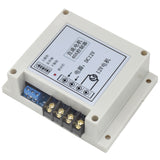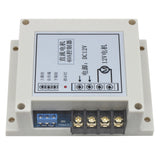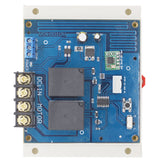Package Include:
1 x Receiver: S1PF-DC12 / S1PF-DC24
1 x Transmitter: CP-3
1 x User manual
Application:
12 volt 24V 1 channel 40A wireless remote control switch kit with RF transmitter and receiver for long range control DC electric motor's the clockwise rotation, counterclockwise rotation, and stopping.
Feature:
Wireless control, easy to install.
Two operating voltage versions: DC 12V or 24V optional.
With limit terminals: You can connect sensors, limit switches or external devices to stop the DC motor.
With wired control terminals: You can connect manual switches to control the DC motor.
You can use the transmitter / remote to control the receiver from any place within a reliable working distance.
The wireless RF signal from the transmitter can pass through walls, floors, doors or windows, but it will lose some operating range.
The receiver has reverse power protection and over current protection built in.
The receiver only works with the selected transmitter which is matched to the receiver.
One or more transmitters / remotes can control one or several receivers simultaneously.
Two or more receivers may be used in the same area.
Receiver Parameters:
Model: S1PF-DC12 / S1PF-DC24
Operating Voltage: 12±1VDC (model S1PF-DC12), or 24±2VDC (model S1PF-DC24), the operating voltage must be specified when ordering.
Output Voltage: 12VDC (model S1PF-DC12) or 24VDC (model S1PF-DC24)
2 control modes: Interlocking, Momentary
Quiescent Current: ≤10mA
Rated Current: 40A, so motor maximum starting current cannot exceed 40A.
Wire range for the terminals: 22-12 AWG
Working Frequency: 433.92MHz
Operating Temperature: -20°C ~ +70°C
Case size: 115 x 95 x 40 mm
Transmitter Parameters:
Model No.: CP-3
Channel/Button: 3
Button Symbol:▲, ■, ▼
Operating Voltage: 12V (1 x 23A -12V battery)
Standby current: 4uA
Operating Current: 14mA
Operating Frequency: 433.92MHz
Transmitting Distance: 500m / 1500ft (theoretically)
Modulation Mode: ASK
Operating Temperature: -20 ° C to +70 ° C
Unit Size: 92 x 40 x 15 mm
Applicable Transmitters:
This receiver can work with different transmitters, such as model CP-3 (500 meters), CG-3 (500 meters, wall mounted) and CB-3-2 (1000 meters).
Working Range:
With a transmitter (such as CP-3) to form a complete set, the maximum working distance can reach 500 meters in an open ground.
The maximum working distance is a theoretical data, it shall be operated in an open ground, no barriers, no any interference. But in the practice, it will be hindered by trees, walls or other constructions, and will be interfered by other wireless signals. Therefore, the actual distance may not reach this maximum working distance.
If you want to have a further working range, you can use a high power transmitter, such as CB-3-2 transmitter.
Usage:
The receiver can be used to control DC 12V / 24V motor. If the power supply of those equipments is DC 12V, you should choose the receiver with same DC 12V version; and if the power supply of those equipments is DC 24V, you should choose the receiver with same DC 24V version.
Wiring:
1) Connect two wires of DC motor to terminals “MOTOR” of the receiver, and you can exchange these two wires to change the rotation direction of DC motor.
2) Connect the positive pole of DC power supply to input terminal “+” of the receiver.
3) Connect the negative pole of DC power supply to input terminal “-” of the receiver.

Setting different control modes:
1) Setting Interlocking mode: Turn the mode switch in the receiver to "L".
The operation by the transmitter, such as CP-3:
Press button ▲ on the transmitter: Motor rotates in positive direction.
Press button ■ on the transmitter: Motor stops.
Press button ▼ on the transmitter: Motor rotates in reversal direction.
Press button ■ on the transmitter: Motor stops.
2) Setting Momentary mode: Turn the mode switch in the receiver to "M".
The operation by the transmitter, such as CP-3:
Press and hold button ▲ on the transmitter: Motor rotates in positive direction; Release button ▲: Motor stops.
Press and hold button ▼ on the transmitter: Motor rotates in reversal direction; Release button ▼: Motor stops.
Limit terminals:
The receiver has limit terminals, and you can connect external devices (with normally closed contact), such as sensors, limit switches to limit terminals, then use them to stop the motor.
For example, you can connect two normally closed limit switches to the limit terminals of the receiver, one to terminals “COM” and “UP”, and the other to terminals “COM” and “DOWN”.

When motor rotates in positive direction, If the limit switch connected to the receiver limit terminals “COM” and “UP” is triggered, the motor will stop automatically.
When motor rotates in reversal direction, If the limit switch connected to the receiver limit terminals “COM” and “DOWN” is triggered, the motor will stop automatically.
Wired control terminals:
The receiver has wired control terminals, and you can connect external devices (with normally open contact), such as manual switches to wired control terminals, then use them to control the motor.
For example, you can connect three manual switches to wired control terminals <S1>, <S2>, <STOP> and <GND> according to following wiring diagram.

1) In Interlocking mode: For example, connect 3 pushbutton manual switch (Model 0040024).
When pressing the UP button, two terminals <S1> and <GND> are connected, then the motor rotates in the positive direction. And when pressing the STOP button, two terminals <STOP> and <GND> are connected, then the motor stops.
When pressing the DOWN button, two terminals <S2> and <GND> are connected, then the motor rotates reversal direction. And when pressing the STOP button, two terminals <STOP> and <GND> are connected, then the motor stops.
2) In Momentary mode: For example, connect 2 pushbutton manual switch (Model 0040025).
When pressing and holding the UP button, two terminals <S1> and <GND> are connected, then the motor rotates in the positive direction. And when releasing the UP button, two terminals <S1> and <GND> are disconnected, then the motor stops.
When pressing and holding the DOWN button, two terminals <S2> and <GND> are connected, then the motor rotates reversal direction. And when releasing the DOWN button, two terminals <S2> and <GND> are disconnected, then the motor stops.















